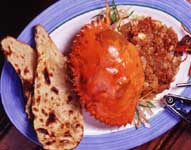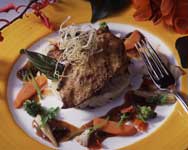That most dreaded question -
“What’s for dinner honey?” just became the common denominator
for social change. Your eating habits make you stand apart, says Gayatri
Jayaraman.

Pasta arabiata and corn-on-the-cob with a salad on the side or a
simple steamed rice and fried pomfret with ‘gassi’? Eating out,
eating in? Shove a packet into the micro or reheat leftovers on the stove? At
the table, on the floor or, sprawled in front of the television? Wait for your
spouse, or just eat when you’re hungry, irrespective of who’s at
home?
With your fingers, with a fork and knife, or both? Will it be a
salad, veggies or no wholesome crap at all? Bread or ‘chapati’?
Accompanied by a glass of cola, juice, water or wine? Eat off a plate or just
out of the bowl?
Let us know and we’ll tell you if you live in a
joint family or a nuclear one, are close to your spouse or in an open
relationship, are single, married, have kids, are conservative, orthodox, or
liberal and carefree, stressed out or relaxed, believe in luxury or are simple
in tastes, a pseudo gourmet or just love all the good things in life. In the new
world order, you are not what you eat, but virtually, how.
THE TILT Given
the new-age obsession with opening a restaurant at the drop of a cricket bat,
one would assume, not without reason, that food, for some strange reason is
gradually becoming a raison d’etre for those of us who’ve reached
the top of the pyramid of desires.
Whether entertaining, relaxing or
exercising, food is more often than not, there, either by its conspicuous
absence or its moderation or excess. A reward, a punishment, a celebration, a
mourning — food is an issue you can’t really ignore.
And so
you have the
Easy Exotic
cookbook by
Padma Lakshmi and a hundred other such that reflect the emphasis on
personalities and lifestyles than the actual art of cooking.

“I suppose this could be called ‘happy medium’
food,” says Padma Lakshmi. “It is prepared relatively fast, and is
not gravely fattening because it avoids things like cream and butter. What I
will not do is eat food that does not taste good.”
Raji Jallepalli,
Indo-American restaurateur of the immensely- popular restaurant Raji in Memphis,
USA, and considered an authority on fusion food (especially Indian and French
cuisines), is another who crossed the sacred line and seas to find harmony in
mixing cuisines.
In her book,
Raji
Cuisines: Indian Flavours, French Passion
, Jallepalli merges ethnicities
and cultures as easily as
gajjar ka
halwa
with ice cream. “Fusion is so widespread now. It has become
associated with cooking that mixes a hundred things in the same recipe. It seems
more like confusion than fusion,” she says. “It’s really a
subtle combination of ingredients, technique and philosophy. It’s
challenging because you want to build a certain complexity of flavours without
having them compete. Balance is essential — it’s about bringing a
symphony of different flavours, while maintaining harmony between the different
ingredients and spices.”
WHAT’S COOKING?

According to Foodservice 2010, a comprehensive study by McKinsey
and Co for the US-based International Foodservice Distributors Association,
Generation X (that’s us) prefer to ‘pick up parts’ of a meal
at a supermarket and ‘assemble’ them to create a meal at home
— much as they would assemble a model car from a kit — without
having to cook from scratch. This new age mantra is a convenient homage to the
memory of mom’s labour-intensive meals.
However, according to the
study, the new ‘Generation Y’ will find home-cooked meals totally
alien and outdoor food services will take over 51 per cent of the worldwide
market for precooked food.
Photograph: Zul Siwani
Model: Rubina
Photograph
courtesy Bay of Bombay, Mumbai
Photograph: Shashi Nair
What's Changing?



